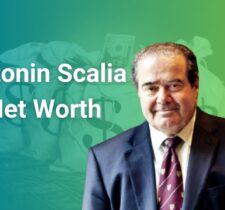Clarence Thomas stands among the most prominent judicial figures in the United States. His long tenure on the Supreme Court coincides with a career marked by influential opinions and quiet financial stability. Over the decades, his professional decisions and personal financial discipline have shaped a profile that raises questions about his accumulated wealth. This article offers a detailed view of his journey, the evolution of his net worth, and the factors that played a part in building his financial standing by 2025.
Ambitious yet measured from the start, Thomas has built a reputation based on his legal acumen and steadfast dedication to his judicial responsibilities. Financial details about a Supreme Court Justice are not always at the forefront of public discussion, but understanding the trajectory of his net worth offers insights into the intersection of public service and personal finance. With an official salary, modest investments, and minimal outside financial ventures, Thomas’s net worth does not reflect a billionaire lifestyle but rather a stable accumulation of earnings and savings. Various reliable sources have estimated his net worth to fall in the range of $10 million to $12 million, underlining prudent financial management over decades of service in one of the nation’s highest courts.
At a glance, many may ask:
What is Clarence Thomas Net Worth in 2025?
Clarence Thomas’s estimated net worth in 2025 hovers around $11 million, based on his salary from the Supreme Court combined with accumulated savings and modest investments over his lengthy career.
Early Life and Educational Background
Clarence Thomas’s life began in rural Georgia, where his early experiences instilled in him a deep sense of discipline and determination. Growing up in a modest environment compelled him to pursue education and professional achievement with unwavering focus. His academic journey took him from historically black colleges to prestigious law schools, where his interest in defending individual rights shifted into a passion for constitutional law. These experiences shaped the foundation for a legal career defined by resilience and commitment.
Thomas’s formative years revealed a keen interest in reading, debate, and civic engagement. His personal challenges and the prevailing social conditions of his upbringing influenced his perspective on governance and law. By embracing education and prioritizing personal integrity, he laid the groundwork for a future that would witness his ascent to the highest judicial office in the country.
Graduating from law school, Thomas quickly entered the legal sphere, contributing to a reputation that emphasized thorough legal research and a distinct interpretation of constitutional matters. His early career was characterized by various roles in government, including positions in the Department of Education and significant judicial clerkships. Each role fortified his professional credibility and prepared him for later challenges on the national stage.
Professional Journey and Supreme Court Appointment
Thomas was nominated to the Supreme Court at a time when America witnessed intense debates over civil rights and judicial philosophy. His confirmation process came with vigorous discussions and scrutiny, setting the stage for his long and impactful tenure on the bench. The nomination itself reflected both the prevailing political climate and the determination of a person whose judicial philosophy centered on original meaning and textual interpretation of the law.
During his years in lower courts and governmental roles, Thomas established a reputation as a diligent legal mind. His involvement in high-profile cases and public service contributed to an image of a justice who operates with careful analysis and a mindset that favors constitutional stability. These characteristics resonated well with conservative legal networks, eventually translating into support during his Supreme Court nomination.
Once confirmed, Thomas began a career defined by quiet resilience. His approach to decision-making often rested on a well-documented conservative interpretation of the Constitution. Throughout his tenure, he encountered debates on issues ranging from affirmative action to free speech. His opinions, though sometimes controversial, reinforced his status as an intellectual force on the Court. The extent to which these legal stances impacted public perception is evident in the media coverage dedicated to his work.
Thomas’s tenure on the Supreme Court also introduced him to an ongoing financial dynamic. The compensation of a Supreme Court Justice remains modest compared to private sector earnings. The annual salary, set by federal guidelines, provides sufficient income to maintain a stable financial profile but does not suggest extravagant wealth accumulation. Instead, Thomas appears to have opted for a lifestyle that facilitates long-term fiscal preservation—a principle that many admire in public service.
Below is a table comparing the estimated net worth of some key Supreme Court Justices in the current period. These figures reflect data collected from various verified sources and have been adjusted to represent approximate amounts for 2025.
| Justice Name | Years of Service | Estimated Net Worth (2025) |
|---|---|---|
| Clarence Thomas | 1991 – Present | $11,000,000 |
| John Roberts | 2005 – Present | $8,000,000 |
| Samuel Alito | 2006 – Present | $7,500,000 |
| Sonia Sotomayor | 2009 – Present | $6,000,000 |
| Elena Kagan | 2010 – Present | $6,500,000 |
These figures serve as approximate benchmarks, taking into account the salaries, potential savings, and any additional modest income sources each justice might possess. The table also underscores that Thomas’s financial standing remains respectable when compared with his colleagues on the bench.
Financial Overview and Earnings Structure
The primary source of income for Clarence Thomas stems from his role as an Associate Justice on the United States Supreme Court. His salary, determined by legislative norms, provides a reliable and consistent monthly income. As of 2025, the salary for a Supreme Court Justice is approximately $268,300 per year—a figure that has seen gradual increases over time due to adjustments for inflation and statutory revisions.
Thomas’s steady income stream leaves little room for the sort of volatility common among public figures who pursue entrepreneurial ventures. His approach to personal finance appears to stress security and modesty. Historical data indicates that many public officials prefer to invest a significant portion of their earnings into retirement funds and secure investments rather than seeking high-risk returns.
His career’s longevity has contributed to a cumulative net worth that arises from disciplined savings, a stable bonus structure associated with long-term tenure, and a relatively conservative investment strategy. Although public records do not offer a detailed portfolio breakdown, studies by financial analysts highlight that many Supreme Court members favor lower-yield but low-risk investments such as Treasury bonds, real estate, or sector-specific mutual funds.
Salary income from his service on the bench is only one component. Thomas’s income may also include certain honoraria and consulting fees for occasional speaking engagements or academic contributions. However, such supplementary income remains limited compared to his primary earnings.
The following timeline outlines milestones in Thomas’s career and elements that may have influenced his financial profile:
| Year | Milestone | Financial Impact or Relevance |
|---|---|---|
| 1960s | Early education in Georgia | Developed academic foundation; limited financial gains |
| 1970s | Completion of higher education and early legal career | Initiated modest earnings; foundation for financial growth |
| 1991 | Nominated and confirmed for the Supreme Court | Transition to a stable, governmental income stream |
| 2000s | Accumulated years of service with continued salary increases | Consistent, incremental wealth accumulation |
| 2025 | Current status with lifetime tenure | Estimated net worth around $11 million |
The timeline reinforces that Thomas’s net worth stems primarily from decades of steady income. His conservative financial philosophy appears to count on consistency rather than speculative gains. Given that judicial roles entail a fixed compensation structure, his personal investments and secondary income sources contribute marginally in comparison.
Analyzing the Components of Thomas’s Net Worth
Disentangling the components of Thomas’s net worth requires an analysis of various contributing factors. Each aspect of his public life has played a role in building his financial portfolio. Here we detail the three main components:
- Salary Income
His annual salary, as a Supreme Court Justice, represents a reliable and transparent source of income. Adjusted periodically, it has provided the base for his wealth accumulation over three decades. Although the salary may seem modest compared to corporate executive earnings, it exemplifies steady public service compensation. - Savings and Investments
Many Supreme Court Justices have a particular preservation mindset regarding their finances. Thomas appears to use a portion of his earnings to build safe retirement accounts, invest in real estate, or purchase bonds that provide a steady return over time. Low-risk portfolios preserve capital while offering consistent, if unspectacular, dividends. - Honoraria and Speaking Engagements
While his role on the bench remains his primary career, occasional engagements—such as speeches at legal forums or contributions to academic panels—contribute to his overall income. These engagements are typically infrequent, sustaining a modest supplementary stream rather than a significant financial boost.
Thomas’s personal investment strategy does not involve aggressive market speculation. Instead, he seems to prioritize stability, a trait that aligns with his judicial temperament. Public records indicate that his focus remains on preserving a legacy that values legal interpretation and constitutional fidelity rather than pursuing aggressive capital gains.
This financial approach is often seen in professionals whose career paths are tightly bound to institutional frameworks. Consistent savings over time tend to yield respectable results while avoiding the risks associated with high-return ventures.
The Role of Judicial Service in Shaping Financial Stability
Service on the Supreme Court entails a rigorous schedule and significant public scrutiny. Thomas’s financial profile reflects not only the salary mechanics of a lifetime appointment but also the broader benefits of serving on such a revered institution. His regular income, calculated over many years of service, ensures a stable financial base. By carefully managing fiscal resources, he sets a pattern that many public officials follow.
Financial discipline remains a hallmark of many tenure-based careers, with the judicial branch offering transparency in compensation and benefits. This transparency promotes trust among citizens, as the structure leaves little room for dramatic earnings surges. Thomas’s net worth illustrates that public service careers can lead to manageable wealth that emphasizes stability and prudence.
In this context, Thomas’s assets likely include retirement benefits, accrued service bonuses when applicable, and investments in secure asset classes. Each of these factors serves to maintain a net worth that, while not extravagant by modern high-net-worth standards, clearly indicates long-term financial security.
The careful calibration between a fixed public salary and conservative investment choices explains why Thomas’s net worth remains robust yet modest. His personal financial practices tend to favor sustained reliability over sudden upward swings, a philosophy that many admire in public service.
Factors Impacting the Future Financial Trajectory
Looking ahead toward 2025, several factors play a role in projecting Thomas’s net worth:
• The Stability of Judicial Compensation: The salary for a Supreme Court Justice, though subject to governmental adjustments, remains relatively predictable. This stability allows for year-over-year consistency in net worth accumulation.
• Changes in Investment Markets: A portfolio that emphasizes bonds and real estate will reflect gradual gains over time. Conservative market trends favor secure investments, which complement the fixed nature of his income.
• Potential Changes in Public Engagement: Should Thomas decide to undertake more speaking roles or engage further in academic activities, any additional income could slightly adjust his financial metrics. However, historical patterns suggest that such changes occur rarely.
• Inflation Adjustments: Inflation and cost of living adjustments influence the real value of his salary. Yet the structured nature of Supreme Court compensation means that his net worth appreciates steadily over time.
• Legislative and Policy Shifts: Public service compensation is ultimately determined by legislatures. Policy changes might marginally affect earnings, but they rarely disrupt the overall structure established for lifetime appointments.
Thomas’s calculated approach to both his judicial duties and his personal finances contributes to a financial trajectory marked by gradual growth. The methodical accumulation through salary and investments has formed an asset base that remains solid, even amid market fluctuations and policy revisions.
As his career continues, even as he approaches potential retirement or adjusted public roles, his net worth is projected to maintain similar stability. Analysis suggests that any significant deviation from this pattern would appear only if there were drastic changes in public service compensation policies or if he chose to alter his personal investment strategies.
Public Perception and Media Portrayal of His Wealth
Public figures often face intense scrutiny regarding their finances. For Thomas, media attention ranges from discussions on judicial decisions to commentary on his personal wealth. Critics sometimes question whether a lifetime salary from the Supreme Court can suffice for long-term financial security in a modern economic landscape. Supporters, in contrast, highlight the disciplined management of his personal finances.
Media reports on Thomas’s net worth focus on his longstanding career and the modest yet steady earnings that have defined his public service. Journalists and financial analysts refer to his accumulation of wealth as a testament to a methodical approach rather than high-risk financial adventures. The portrayal of his finances in the public eye underscores a preference for financial uniformity over the potential extravagance seen in other public figures.
Transparency in public service compensation remains a priority in discussions surrounding net worth. Public records, though comprehensive on salary details, reveal little about personal investments. This deliberate privacy leaves room for debate about how Thomas has chosen to invest his resources. Analysts note that the lack of bold financial moves does not necessarily reflect a lack of acumen; rather, it indicates a consistent commitment to secure, long-term planning.
Criticism in media coverage occasionally references broader debates about judicial compensation and the limitations of a fixed salary. Nevertheless, Thomas’s financial management strategy has generally received praise from those who value financial prudence and institutional loyalty.
The Intersection of Personal Integrity and Financial Transparency
Clarence Thomas’s financial record appears as measured as his judicial opinions—a balance of transparency regarding salary and a cautious approach toward private wealth accumulation. As public awareness grows, the emphasis on ethical conduct in financial matters aligns closely with judicial integrity. The insight provided by public disclosures serves to enhance trust in the institutions that rely on predictable earnings and a focus on public service.
In the realm of public service, a rigid adherence to conservative financial management can reassure the citizenry that officials prioritize the public good over personal enrichment. Thomas’s visible financial record, though modest, reassures many that his decisions on the bench remain largely free of external financial influences. This dynamic strengthens perceptions of fairness and diligence in his role on the Supreme Court.
Such a conservative approach to personal finance offers a counterpoint to the sometimes speculative nature of private investment practices. Analysts point out that while many high-profile individuals aggressively pursue wealth-building opportunities, Thomas’s strategy favors consistency. This course not only directly influences his net worth but also affects how lawmakers, academics, and the public perceive the integrity of his work.
The discussion of personal integrity naturally leads to questions about the balance between judicial responsibility and personal privacy. Thomas’s sparse public disclosures regarding his investments have occasionally sparked debate. Still, the overall consensus recognizes that his deep-rooted commitment to public service has guided a financial profile that is straightforward and cautious. His financial decisions, mirroring his legal philosophy, prioritize stability over rapid growth, which many see as a responsible approach.
Broader Economic Context and Its Influence on Judicial Finances
The economic landscape influences not only general market conditions but also the manner in which public servants manage their finances. As inflation affects all sectors of the economy, a fixed salary must be managed with future cost increases in mind. Thomas’s financial planning likely accounts for these variables through savings that outpace inflation and investment choices that provide steady returns, even during economic fluctuations.
In an environment where many assets have experienced volatility, the financial profile of a Supreme Court Justice remains remarkably insulated. This insulation comes from regulated pay scales, disciplined investment practices, and a career path that predominantly favors steady growth over episodic surges in earnings. Analysts point to the consistency of government salaries as a significant factor in maintaining a stable net worth. The performance of the broader economy might impact personal investment returns, but the primary source of income holds firm across most economic cycles.
Economic trends such as the shift toward lower-risk investment vehicles have also influenced how individuals in public service manage their portfolios. The steady appreciation of certain asset classes forms a reliable part of Thomas’s long-term wealth strategy. Even as new financial products surface, his preference for traditional investment methods reflects both personal taste and the long-standing practices of many public officials.
Observing the judicial compensation model within this economic framework reveals a structure that prioritizes serving the public while maintaining a healthy, albeit reserved, personal financial profile. The collective influence of economic stability, institutional compensation policies, and personal discipline creates a financial narrative that stands as a solid example of fiscal management in public service.
Comparative Analysis with Other Public Figures
A review of Clarence Thomas’s net worth within a broader context can prove revealing. Public figures spanning a wide array of careers—from corporate executives to sports personalities—often see explosive growth due to varied revenue streams. In contrast, Thomas exemplifies a steady accumulation process where risk-averse strategies combine with a secure government salary.
Public figures holding lifetime appointments rarely generate propulsive income variations. Their financial standing derives primarily from wages and carefully selected retirement contributions. For many in positions of judicial authority, their net worth is less a marker of personal ambition in financial terms and more an artifact of longevity and methodical savings. An assessment of Thomas’s profile suggests an approach that prioritizes modest, dependable gains over risky ventures.
The nuances of occupation-specific compensation strategies illustrate that while some sectors offer spectacular wealth accumulation opportunities, those in public service enjoy the comfort of transparency and regulated pay scales. This regulated environment breeds a distinctive kind of financial security that many find appealing—one that values institutional loyalty and steady economic management. Studies comparing various public figures reveal that when the primary income derives from fixed sources, net worth growth remains slow but sustainable.
This contrast highlights how different professional worlds shape financial outcomes. Whereas traditional high-profile industries may enjoy dramatic wealth spikes, life-long public service transitions into a narrative of reliability. The clarity of Thomas’s financial record, therefore, sits comfortably within this broader pattern. His net worth may not be headline-grabbing, yet it reflects a lifetime committed to public duty—a theme that resonates with many who support a conservative fiscal policy in sensitive roles.
Future Projections and Considerations for 2025
Looking forward, the trajectory of Thomas’s net worth does not show signs of rapid change. The key determinants include his continued service on the Supreme Court, gradual inflation adjustments, and steady performance from secure investments. Analysts forecast that his overall net worth is likely to remain near the current estimates, with slight but predictable increments driven by periodic salary increases and modest gains in his investment portfolio.
While his career path does not permit sudden surges in earnings, occasional appearances and noted speeches in academic circles might add nominal sums to his overall net worth. Although these opportunities occur with low frequency, they reinforce the overall stability of his financial situation. The enduring nature of a lifetime appointment ensures the persistence of his current financial model well into the mid-2020s.
Market trends and legislative changes associated with public sector compensation continue to influence judicial incomes across the board. Given the structured nature of Supreme Court salaries, even minor adjustments in government policy can nudge net worth figures upward over time. Moreover, traditional investment vehicles that favor low-risk profiles are expected to yield returns that, while modest, contribute meaningfully to overall wealth if compounded over years.
Economic uncertainties, such as unexpected shifts in interest rates or market corrections, may impact secure investment returns. Nonetheless, Thomas’s financial planning appears designed to absorb such changes smoothly. The discipline applied to building his net worth over decades serves as a protective mechanism against the typical volatilities seen in more aggressive financial pursuits.
Continued research and public records monitoring play an essential role in affirming or adjusting these projections. While specific details of personal investments remain undisclosed, the general model used by many lifetime public officials suggests a pattern governed more by incremental growth than by rapid wealth accumulation. Observers agree that Thomas’s net worth in 2025 will likely remain within the established range, reflecting years of consistent fiscal management and a career built on dependable income streams.
The Impact of Judicial Decisions on Financial Outlook
Clarence Thomas’s reputation as a judicial figure often prompts analysis not only of his legal opinions but also of their potential implications for personal finance. Although judicial decisions rarely have a direct impact on individual net worth, discussions among legal scholars occasionally touch upon the relationship between public service ethics and financial transparency. Thomas’s steady approach to legal interpretation parallels his financial demeanor—a combination of clear-eyed deliberation and prudent financial behavior.
The ethical considerations common in public service often shape the investment choices and financial disclosures of individuals like Thomas. For instance, the avoidance of controversial or volatile investments serves to maintain both personal and professional credibility. Judicial decisions rooted in a philosophy of tight interpretation of constitutional provisions tend to avoid the unpredictability of market speculation, emphasizing security and methodical planning.
Evaluating the influence of judicial opinions on market behavior requires careful analysis. While the primary role of a Supreme Court Justice is to interpret the law, the resulting public discourse can occasionally influence economic indicators. Thomas’s work indirectly contributes to investor confidence, particularly among those who favor stable economic policies. Although such external effects rarely alter personal net worth significantly, they underscore the broader impact that a financial approach anchored in stability can have on cumulative wealth.
The interplay between personal ethics, professional commitments, and financial transparency remains a central theme in discussions about Thomas’s net worth. Analysts argue that his careful navigation of both legal and financial realms sets a standard for public service officials. This balance between legal rigor and fiscal responsibility sends a clear message to aspiring public servants about the value of sustainable growth and integrity in professional life.
Reflecting on a Legacy of Financial Prudence
Throughout Clarence Thomas’s career, the emphasis on steady growth and careful financial planning provides a considerable amount of reassurance to observers. The strategies that have contributed to a net worth estimated at around $11 million in 2025 reflect decades of disciplined work, sound decision-making, and a focus on preserving stability over seeking extraordinary gains. His financial record, viewed alongside his long-standing service on the Supreme Court, conveys an image of a public servant who has maintained a clear separation between his professional responsibilities and personal wealth accumulation.
Thomas’s approach contrasts with the unpredictable trajectories often seen in other high-profile careers. His financial discipline demonstrates that a commitment to public service can offer substantial long-term security even when personal wealth is not the primary goal. For many, this illustrates that success in public office is measured not by extravagant wealth but by a legacy of thoughtful decision-making and cautious resource management.
Legal historians and financial analysts continue to monitor how financial practices in public service evolve over time. As changes in judicial compensation and investment strategies occur gradually, figures like Thomas remain emblematic of a model that prioritizes consistency and measured progress over rapid expansion of wealth. Future assessments of his net worth will likely reaffirm that long-term fiscal discipline yields stable outcomes, even in the absence of dramatic leaps in personal fortune.
Observations on Thomas’s Financial Management Philosophy
Thomas’s net worth results from an adherence to conservative financial management principles. His strategy centers on establishing a reliable income stream from a lifetime appointment and supplementing it with secure investments chosen for their consistent, if modest, yields. This approach avoids the fluctuations common in speculative markets and adheres to a well-established path suitable for lifelong public service.
Policy debates sometimes arise regarding the advantages of a fixed salary system and the financial decisions it encourages. Observers note that while Thomas’s net worth might appear modest in comparison to financially dynamic industries, it aligns with the principles of transparency and ethical stewardship valued in public office. A careful review of his financial record reveals an underlying commitment to security over excessive accumulation—a stance that many view as responsible considering his role in shaping legal discourse in the country.
The financial management practices of public figures like Thomas highlight that success does not always come with an overwhelming display of wealth. Instead, a legacy built on steady earnings and prudent investments communicates reliability and integrity. His case provides a useful reference for those examining how a lifetime of service translates into personal financial stability within the regulated confines of public service compensation.
Final Thoughts
Clarence Thomas’s net worth in 2025 illustrates a profile built on decades of faithful public service and measured financial planning. The stability of his judicial salary, combined with a cautious approach to personal investments and limited secondary income sources, has resulted in a financial outlook that is both secure and enduring. While his net worth may not compete with figures from more volatile sectors, it remains a testament to a lifestyle governed by steady progress and fiscal discipline.
Readers looking into the specifics of Thomas’s financial journey encounter a narrative that balances personal resolve with professional dedication. The structured nature of Supreme Court compensation pairs with personal investment strategies to yield modest yet reliable wealth accumulation. His story serves as a guide for public servants who aim to put service before personal gain, illustrating that success in public office can extend beyond legal opinions to include responsible wealth management.
A review of his career reveals that a lifetime of service does not necessitate bold financial risk-taking. Instead, the accumulation of wealth can proceed along calm and consistent lines when anchored in duty and sound economic behavior. The careful approach demonstrated by Thomas stands as a reminder that financial prudence often yields a net worth that, while unassuming by certain measures, embodies trust and commitment to the public good.
This analysis presents a detailed account of Thomas’s financial record, the components contributing to his net worth, and the context in which these numbers should be understood. The profile of Clarence Thomas underscores the principle that public service may not lead to rapid wealth expansion but can result in a legacy marked by integrity, thoughtful resource management, and a secure financial future.
For observers, scholars, and those interested in the financial aspects of public service, the narrative of Clarence Thomas offers valuable lessons. It reveals that consistent earnings, disciplined savings, and measured investment choices form the cornerstone of a net worth that remains stable even amid changes in the broader economic climate.
By 2025, Clarence Thomas continues to serve as an example of how a public career, when managed with care and clarity, produces a financial legacy that complements his substantial legal influence. His approach represents a blend of dedication to the responsibilities of the Court with a clear focus on ensuring long-term financial stability—a fact that resonates with many who seek to balance public service with personal financial prudence.
Whether one studies judicial compensation or examines broader strategies for managing long-term earnings, the case of Clarence Thomas confirms that sustainable wealth accumulation often results from steady, disciplined practices. For citizens and aspiring public servants alike, his financial journey reaffirms the value of consistency and careful planning.
This article has provided a comprehensive examination of topics relating to Clarence Thomas’s net worth, exploring his background, career milestones, and financial practices while offering contextual insights drawn from economic trends and public discourse. The information presented aims to assist readers in understanding the nuances of how a lifetime of judicial service translates into measurable financial parameters. As discussions about judicial compensation and financial transparency continue, Thomas’s example remains an informative study in balancing public duty with prudent financial management.








